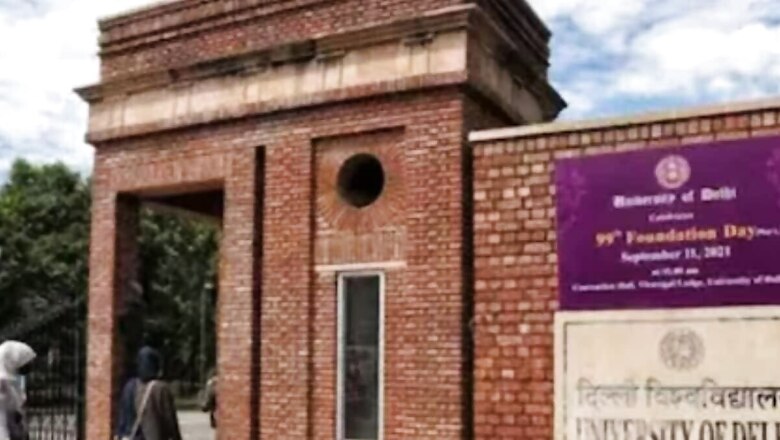
views
Delhi University’s revenue collection from student fees has more than doubled in the past five years, with over Rs 200 crore amassed in the previous fiscal year, even as funds from UGC grants have largely remained underutilised.
According to data shared by its finance department, the university’s internal receipts (fund inflow), which mainly includes fees of students but also other items such as consultancy fees, stood at nearly Rs 100 crore in 2019-2020. The figure rose to over Rs 200 crore in the year 2023-24.
The varsity’s grants from the University Grants Commission (UGC) over the 5 years have increased in absolute terms but there is a downward trend in the share of UGC grants in the total fund inflow (receipts).
In 2019-2020, DU received around Rs 600 crore from UGC and in 2023-2024 a little less than Rs 800 crore, data shows.
The share of UGC grants inflow has fallen from around 83 per cent to 77 per cent between 2019-20 and 2023-24, indicating that the role of public funding in the running of Delhi University is declining, said a professor of commerce at DU.
“Moreover, the magnitude of total receipts now exceeds the total expenditure of Delhi University and this trend emerged in the last two years. This demonstrates that there has been an under utilisation of funds from total receipts,” he added.
There was no immediate comment on this data from the university officials.
DU imposed a fee hike in July across its degree programs, including a 60 per cent increase in PhD courses. In December last year, DU raised its annual charges by 46 per cent, marking the second hike within a year.
Several professors of the university have alleged that this was an attempt to recoup the interest on the Higher Education Financing Agency (HEFA) loan from students’ pockets.
HEFA is a joint venture of Canara Bank and the Ministry of Education, providing financial assistance for developing educational infrastructure and research facilities in India’s premier educational institutions.
“The government is pushing educational institutes to generate their own funds, and student fees are a major source from which institutes can generate revenue. However, this approach risks denying education to a significant portion of society that cannot afford such exorbitant fees,” said Abha Dev, secretary, of the Democratic Teachers’ Front (DTF). “The central university’s mandate is to provide mass education, yet initiatives like HEFA are undermining this principle. It is crucial to investigate how these loan funds are being utilised,” she added.
DU received its major funding — 76.6 percent — of the total inflow of funds in the financial year 2023-24 from UGC grants, with the remaining 23.4 percent coming from internal sources such as student fees, according to university data.
In October last year, HEFA approved a loan corpus of Rs 930 crore for DU, requiring the university to pay 10 per cent interest to the lending agency, while the Central government would cover the remaining 90 per cent.
As a result of the fall in the share of UGC grants, DU plans to generate revenue from both internal and external sources through various mechanisms in the medium and long term, as per the university’s Institutional Development Plan (IDP) 2024-2047.
Among the strategies is renting existing facilities, such as auditoriums, labs, classrooms, and guest houses, to external agencies. The university also plans to establish department-specific souvenir shops (based on contractual manufacturing) to promote in-house development.
Additionally, individual departments will be allowed to create endowment funds through grants from alumni, philanthropists, and industry collaborations. DU further plans to establish a special chair for multinational companies, which can promote research at the university in their interest.
An Investment Committee will be set up, if necessary, to oversee and evaluate all financial plans of the university, the IDP states.




















Comments
0 comment